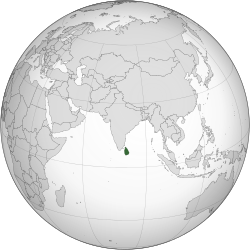Dominion of Ceylon
| Ceylon | ||||||||||
|
||||||||||
|
||||||||||
|
Anthem Sri Lanka Matha Mother Sri Lanka Royal anthem God Save the Queen |
||||||||||
| Capital | Colombo | |||||||||
| Languages | Sinhala · Tamil · English | |||||||||
| Religion | Buddhism · Hinduism · Christianity · Islam | |||||||||
| Government | Parliamentary democracy | |||||||||
| Monarch | ||||||||||
| • | 1948–1952 | George VI | ||||||||
| • | 1952–1972 | Elizabeth II | ||||||||
| Governor-General | ||||||||||
| • | 1948–1949 | Henry Monck-Mason Moore | ||||||||
| • | 1949–1954 | Lord Soulbury | ||||||||
| • | 1954–1962 | Oliver Ernest Goonetilleke | ||||||||
| • | 1962–1972 | William Gopallawa | ||||||||
| Prime Minister | ||||||||||
| • | 1948–1952 | Don Senanayake | ||||||||
| • | 1952–1953 | Dudley Shelton Senanayake | ||||||||
| • | 1953–1956 | John Lionel Kotalawela | ||||||||
| • | 1956–1959 | S. W. R. D. Bandaranaike | ||||||||
| • | 1970–1972 | Sirimavo Bandaranaike | ||||||||
| Legislature | Parliament of Ceylon | |||||||||
| • | Upper house | Senate | ||||||||
| • | Lower house | House of Representatives | ||||||||
| Historical era | 20th century | |||||||||
| • | Independence | 4 February 1948 | ||||||||
| • | JVP Insurrection | 1971 | ||||||||
| • | Republic | 22 May 1972 | ||||||||
| Area | ||||||||||
| • | 1948 | 65,610 km² (25,332 sq mi) | ||||||||
| Population | ||||||||||
| • | 1948 est. | 7,060,000 | ||||||||
| Density | 107.6 /km² (278.7 /sq mi) | |||||||||
| • | 1956 est. | 8,100,000 | ||||||||
| Density | 123.5 /km² (319.8 /sq mi) | |||||||||
| • | 1962 est. | 11,000,000 | ||||||||
| Density | 167.7 /km² (434.2 /sq mi) | |||||||||
| • | 1971 est. | 12,800,000 | ||||||||
| Density | 195.1 /km² (505.3 /sq mi) | |||||||||
| Currency | Ceylon Rupee | |||||||||
|
||||||||||
| Ashley Havinden, Michael; David Meredith. Colonialism and development: Britain and its tropical colonies, 1850–1960. p. 12. "Sri Lanka". "Ceylon Independent, 1948–1956". World History at KMLA. |
||||||||||
Between 1948 and 1972, Ceylon was an independent country in the Commonwealth of Nations that shared a monarch with Australia, Canada, New Zealand and the United Kingdom, and certain other sovereign states for other years between 1948 and 1972. In 1948, the British Colony of Ceylon was granted independence as Ceylon. In 1972, the country became a republic within the Commonwealth, and its name was changed to Sri Lanka. It is an island country in South Asia, located about 31 kilometres (19.3 mi) off the southern coast of India.
The country was a centre of the Buddhist religion and culture from ancient times as well as having a strong Hindu presence.
During World War II, Ceylon served as an important base for the Allied forces in the fight against the Japanese Empire.
Following World War II, public pressure for independence increased. The British Colony of Ceylon achieved independence on 4 February 1948, with an amended constitution taking effect on the same date. Independence was granted under the Ceylon Independence Act 1947. Military treaties with the United Kingdom preserved intact British air and sea bases in the country; British officers also continued to fill most of the upper ranks of the Army. Don Senanayake became the first Prime Minister of Ceylon. Later in 1948, when Ceylon applied for United Nations membership, the Soviet Union vetoed the application. This was partly because the Soviet Union believed that the Ceylon was only nominally independent, and the British still exercised control over it because the white, educated elite had control of the government. In 1949, with the concurrence of the leaders of the Sri Lankan Tamils, the UNP government disenfranchised the Indian Tamil plantation workers. In 1950, Ceylon became one of the original members of the Colombo Plan, and remains a member as Sri Lanka.
...
Wikipedia




